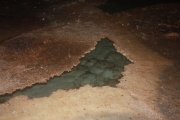Calcite (Inventory)/Shelfstone
From LagWiki

The Shelfstone field of the Calcite section should be used to record any observation of shelfstone.
Shelfstone is a flat ledge of calcite that grew at the edge of a pool. It extends inwardly creating a ledge above the water. They can also form around other speleothems such as columns and stalagmites to form tables and lily pads.
Shelfstone forms at the pool surface and if the pool level changes over time, multiple levels of shelfstone can form. Shelfstone can be left high and dry when a former pool has dropped or disappeared. Its presence indicates a former pool level or paleo-waterline. Shelfstone is usually only a few centimeters thick but its width can vary greatly even up to several meters. Chenille/Pool spar, pool fingers and subaqueous helictites can be found under shelfstone so be sure to examine it for these speleothem types. Shelfstone may not be thick enough nor strong enough to support weight without breaking so take great care when crossing shelfstone and keep your weight on the more substantial surfaces.
Look for shelfstone at the edges of any pool or former pool.
See also
References
- Hill, Carol; Paolo Forti (1997) Cave Minerals of the World (Second Edition ed.) National Speleological Society pp 97-98 ISBN: 1-879961-07-5
- Palmer, Arthur N. (2007) Cave Geology CAVE BOOKS, Dayton, OH p 278 ISBN-13: 978-0-939748-66-2, ISBN-10: 0-939748-66-5
